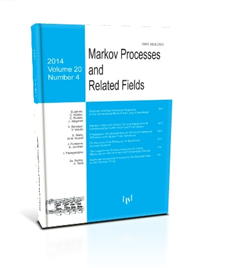The Liquid and Vapor Phases in Particle Models with Kac Potentials
F. Baffioni, I. Merola, E. Presutti
2002, v.8, Issue 2, 271-318
ABSTRACT
We consider here the model introduced in [J.L. Lebowitz, A. Mazel and E. Presutti, Liquid-vapor phase transitions for systems with finite-range interactions, J. Stat. Phys., 1999, v. 94, N5-6, 955-1025] to study phase transitions for point particles in the continuum. The mean field phase diagram of the model in the $(\beta,\lambda)$-plane, $\lambda$ the chemical potential, $\beta$ the inverse temperature, consists of a smooth curve $\lambda=\lambda(\beta)$, $\beta>\beta_c>0$, where two phases (liquid and vapor) coexist, elsewhere the phase is unique. In the mentioned paper it has been proved that phase transitions (in the sense of non uniqueness of DLR measures) persist when the mean field interaction is replaced by a Kac potential with small but fixed scaling parameter $\gamma$ (mean field being derived in the limit $\gamma\to 0$). In particular it is shown that for any $\beta>\beta_c$, there is a phase transition at $\lambda=\lambda(\beta,\ga)$ for any $\gamma$ small enough with $\lambda(\beta,\gamma)\to\lambda(\beta)$ as $\gamma\to 0$. Here we complete the analysis of the phase diagram by showing that if $\lambda\ne\lambda(\beta)$, then, for all $\gamma$ small enough, there is a unique DLR measure.
Keywords: Pirogov - Sinai theory,Peierls estimates,Vaserstein distance,disagreementpercolation
COMMENTS
Please log in or register to leave a comment

